Using 120 Film in 620 Cameras
Vintage Cameras Home
|
|
Many good cameras were made in the first half of the Twentieth Century which used the now-obsolete 620 format. Kodak, in particular, made some excellent cameras which can often now be obtained for next to nothing because most people do not want to be troubled with obtaining film in a size no longer available over the counter. However, there are several methods available for modifying still-available 120 film rolls so that they will fit in many cameras originally designed to accept only the 620 format.
|
|
The problem in fitting a 120 film roll into a camera intended to take 620 is illustrated in the photo to the right. The film and paper backing are essentially identical. However, the 620 spool is very slightly shorter, it has smaller diameter disks at each end, and the axle hole and slot is smaller on the 620 spool than in the 120 size. The length difference is insignificant in most cameras that have spring-loaded spool holders as they will adapt to the difference in spool lenth. The larger axle hole and slot diameter will often pose a problem for using a 120 spool on the take-up side in a 620 camera; however, this is easily remedied by salvaging a few 620 spools from cheap box cameras. That leaves just the problem of the over-size disks on each end of the 120 film spool which will often not fit into the film compartment of a camera meant to use 620 film.
| 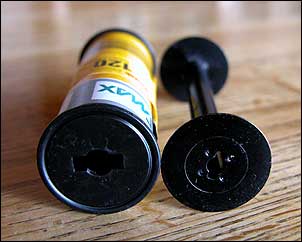
| |
|
|
The solution I have found easiest to adapting 120 film to 620 cameras is simply to add a manicure set to my camera kit. All you will need is a pair of high-leverage nail trimming scissors and a nail file. A popular alternative is to re-spool the 120 film and paper backing onto a old 620 spool. However that requires a fully darkened room or dark bag, and you will need to accomplish the whole task completely in the dark.
| 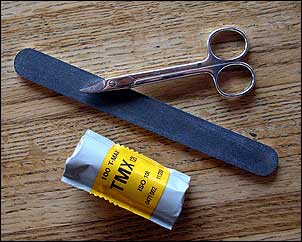
|
|
Kodak 120 film spools are made of plastic that is tough, but not brittle. A pair of sharp nail scissors will enable you to cut the disks at the spool ends to the proper size to fit into the film chamber of a camera designed to accept 620 film. By taking small bites with the scissors and guiding them along the groove near the end disk's outer edge, you can trim off the excess diameter so that the disk is nearly flush with the paper backing and approximately the same size in diameter as the old 620 spools.
| 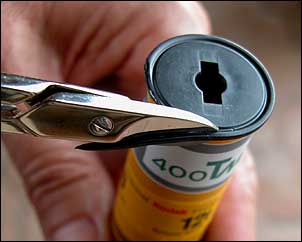
|
|
The initial trimming with the scissors is likely to leave an uneven border on the disks at each end of the spool. I like to use a sandpaper-like nail file to do the final smoothing of the disk edges. Done properly, the result will be a roll of film that winds very easily from start to finish in your 620 camera. In handling the film roll during the trimming process, it is probably a good idea to avoid gripping the roll too tightly which might deform the roll of film slightly and cause light leaks along the borders of the film. I also like to do the whole process away from bright light sources and I store my trimmed film cartridges in a dark container as well.
| 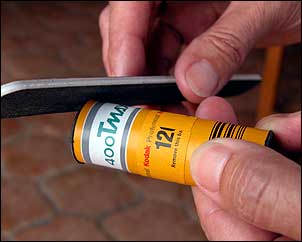
|
The final picture to the right shows a roll of trimmed 120 film loaded in my Kodak Vigilant -- a camera with a Tessar-style lens that cost me about $12. The trimmed 120 spool is at the bottom. The paper backing of the film has been threaded into the slot of an old metal 620 film spool at the top which was salvaged from a Kodak Brownie Hawkeye. It is important to carry several such 620 spools in your kit as once you use the film, the spool it is wound onto is no longer available until you have developed the film.
There are some cameras in which the above procedure simply won't work because of the design of the film chamber. For instance, the Kodak Duo Six-20 won't let me fit a trimmed 120 spool into the supply side. In this case, re-rolling onto a 620 metal spool is the only good option. (The technique for rerolling 120 film onto 620 reels is explained and illustrated in an entry on my blog.)
My best results have come from rolling the film onto one 620 spool and then back onto another. The reason for using two 620 spools in the process is that the final roll is going between two spool cores of the same diameter, which minimizes buckling of the taped joint between film and backing, and eliminates the need to reposition the tape. When re-rolling onto the second spool it is necessary to tuck the film end under the paper near the beginning. This method is more time-consuming than trimming, but in some cases the smoothness of the film advance in the camera will be greatly improved.
| 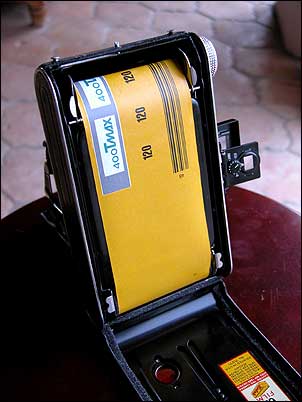
|
There was a posting at photo.net recently which suggested that the problem with trimmed 120 spools in some cameras results from the over-sized holes in the 120 spool ends which cause the cartridges to jam. The suggested solution was to fill the spaces on either side of the main hole with pieces of toothpick or something similar.
If you are willing to spend ten or twelve dollars for a roll of 620 film, it is also possible purchase it ready to use from a couple places. Some of the film is 120 that has been re-rolled, but it appears that B&H also now has some new Kodak-made 620. No telling how long that availability may endure, but it does seems there is a solution one way or another that nearly anyone can live with.
Vintage Cameras Home
|




